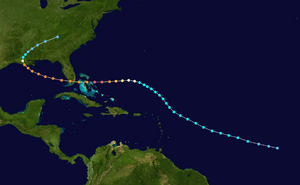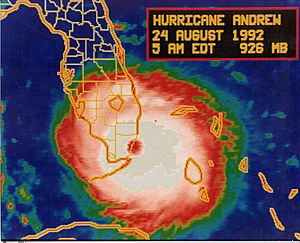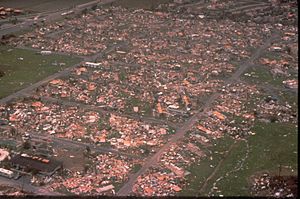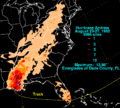Hurricane Andrew facts for kids
| Category 5 major hurricane (SSHWS/NWS) | |
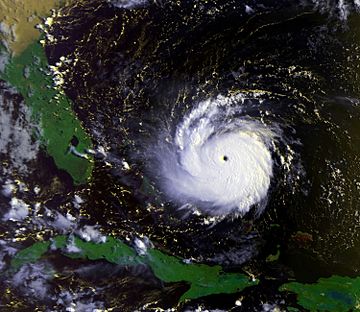
Hurricane Andrew approaching the Bahamas and Florida as a Category 5 hurricane
|
|
| Formed | August 16, 1992 |
|---|---|
| Dissipated | August 28, 1992 |
| Highest winds | 1-minute sustained: 175 mph (285 km/h) |
| Lowest pressure | 922 mbar (hPa); 27.23 inHg |
| Fatalities | 26 direct, 39 indirect |
| Damage | $26.5 billion (1992 USD) (Second costliest tropical cyclone in U.S history) |
| Areas affected | Bahamas; South Florida, Louisiana, and other areas of the Southern United States |
| Part of the 1992 Atlantic hurricane season | |
Even though the 1992 Atlantic hurricane season had fewer storms than usual, Hurricane Andrew was a very powerful exception. This huge hurricane hit the Bahamas, southeast Florida, and south-central Louisiana. Its path was very similar to Hurricane Betsy, another storm that hit Florida and Louisiana.
However, unlike Betsy, Andrew did not cause major flooding in New Orleans. The damage from Hurricane Andrew was mostly caused by its incredibly strong winds. It caused between $23 billion and $37 billion in damage (in 1992 money). Between 56 and 68 people lost their lives. This made Andrew the most expensive Atlantic hurricane to hit the United States at that time. Later, Hurricane Katrina caused even more damage.
Contents
Aftermath of Hurricane Andrew
| Rank | Hurricane | Season | Damage | ||
|---|---|---|---|---|---|
| 1 | Katrina | 2005 | $108 billion | ||
| 2 | Sandy | 2012 | $71.4 billion | ||
| 3 | Ike | 2008 | $29.5 billion | ||
| 4 | Andrew | 1992 | $26.5 billion | ||
| 5 | Wilma | 2005 | $21 billion | ||
| 6 | Ivan | 2004 | $18.8 billion | ||
| 7 | Irene | 2011 | $15.6 billion | ||
| 8 | Charley | 2004 | $15.1 billion | ||
| 9 | Rita | 2005 | $12 billion | ||
| 10 | Frances | 2004 | $9.51 billion | ||
| Source: National Hurricane Center | |||||
Impact on Florida
After Andrew, many rumors spread about the damage. Some people claimed that thousands of farm workers in south Dade County (now Miami-Dade County) had died. However, an investigation by the Miami Herald newspaper found no proof for these rumors. These stories might have come from the 1928 Okeechobee hurricane, where many worker deaths were not counted right away.
People in southern Florida felt that federal help was too slow to arrive. Dade County emergency director Kate Hale became well-known for asking for help on TV. She famously asked, "Where in the hell is the cavalry on this one?" Soon after, President George H. W. Bush promised help. Mobile kitchens, tents, and soldiers from the 82nd Airborne Division quickly arrived to assist.
The huge amount of damage from Andrew caused big problems for insurance companies. Eleven insurance companies went out of business, and many others lost a lot of money. Almost a million homes could no longer get insurance coverage. Because of this, the Florida Legislature created new agencies. These agencies, like the Joint Underwriting Association, helped people get important insurance again.
Homeowners and officials also criticized how some buildings were constructed. An investigation after the storm suggested that some buildings might have had construction flaws. Florida had strict building rules since 1986, but they might not have been followed.
Hurricane Andrew also had a big impact on Florida's natural areas. In the Florida Everglades, about 70,000 acres (280 km²) of trees were knocked down. It took about 20 days for new plants to start growing back. The storm also affected marine life. It lowered the oxygen levels in the water, which harmed many fish. About 182 million fish died, causing a loss of $160 million (in 1992 money).
In the ten years after the storm, Hurricane Andrew may have helped cause a big housing boom in Broward County, Florida. Many people who lost their homes moved north to areas that were just starting to be developed. This led to fast growth in places like Miramar, Pembroke Pines, and Weston.
Impact on Louisiana
In Louisiana, Hurricane Andrew knocked down 80% of the trees in part of the Atchafalaya River Basin near the coast. Offshore, the storm killed 9.4 million fish, which was a loss of $7.8 million (in 1992 money). It also damaged large areas of marshland along the Louisiana coast.
About 6,200 people needed shelter in 36 different places, according to the American Red Cross. The Salvation Army sent 37 mobile food trucks. These trucks served 40,000 meals to help people who had little or no food.
The Pentagon sent federal aid to Louisiana. This included four large generators, 2,500 cots, and 30,000 MREs (prepackaged meals). About 1,279 National Guard members were sent to Louisiana. They helped with many tasks, from cooking to patrolling.
Sheriffs along the Louisiana coast suggested a curfew from 6 p.m. to 6 a.m. local time to keep everyone safe.
Retirement of the Name Andrew
Because Hurricane Andrew caused so much damage in Florida and Louisiana, its name was officially "retired" in the spring of 1993. This means the name "Andrew" will never be used again for an Atlantic hurricane. The name "Alex" was chosen to replace it for the 1998 Atlantic hurricane season.
Images for kids
-
Visual comparison of Hurricane Floyd and Hurricane Andrew while at similar positions and nearly identical intensities
-
Damage in Lakes by the Bay
-
Clean-up after Hurricane Andrew in Dade County
See also
 In Spanish: Huracán Andrew para niños
In Spanish: Huracán Andrew para niños


